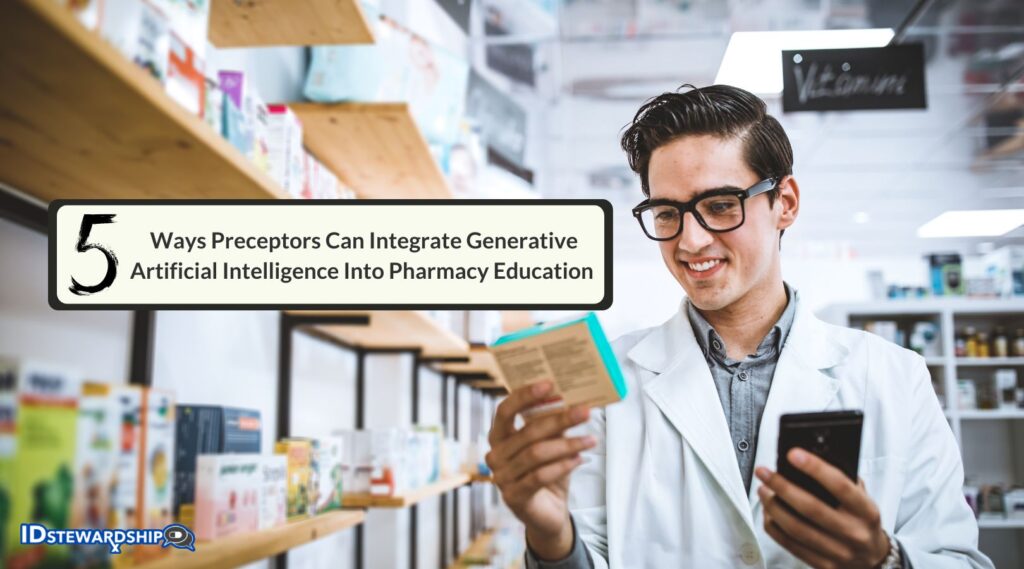In this article a clinical pharmacist discusses ways that preceptors may integrate generative artificial intelligence programs into pharmacy education for student and resident learning experiences.

Authored By: Timothy P. Gauthier, Pharm.D., BCPS, BCIDP
Generative artificial intelligence was NOT used to create this text. Although, maybe it would be better if I had used it!
Article posted 13 December 2023
Artificial intelligence (AI) is a hot topic today. At all of the major conferences lately there seems to be well-attended lectures on AI and often it will be a focus or mentioned item in keynote speeches. In this article I will discuss the topic, provide some resources, and propose five ways that preceptors may integrate generative artificial intelligence programs into pharmacy education for student and resident learning experiences.
Let’s start with some definitions:
- Artificial Intelligence (AI): the simulation of human intelligence processes by machines
- Machine Learning (ML): a branch of artificial intelligence and computer science, focusing on the use of data and algorithms to imitate the way that humans learn, gradually improving accuracy
- All ML is AI, but not all AI is ML
- Generative Artificial Intelligence (GenAI): artificial intelligence capable of generating text, images, or other media, using generative models. Generative AI models learn the patterns and structure of their input training data and then generate new data that has similar characteristics.
- GenAI is focused on creating new data that resembles training data, while ML is focused on analyzing data to find patterns and make accurate predictions.
- GenAI is good for learning from itself to solve problems in succession, while ML is good for solving one problem at a time.
- Chat GPT from OpenAI is an example of GenAI
- Deep learning: a type of ML based on artificial neural networks in which multiple layers of processing are used to extract progressively higher level features from data
As I was researching this topic, I came across an article by Dr. Jeff Cain and colleagues published in AJPE that discusses the role of AI in the future of pharmacy education. Two of their quotes resinated with me. The first was: “AI will not replace you. Someone using AI will.” This point is well taken and indicates future and current pharmacists need to become educated about how to use AI, including the benefits and dangers it may offer. The second quote was “pharmacies have diligently transitioned from apothecaries into problem solvers, educators, and communicators.” This resonates with me on the topic, as pharmacy preceptors should consider how they can employ AI to help their learners become better problem solvers, educators, and communicators.
In terms of pharmacy education research on the topic of AI, there is not a lot out there. A scoping review on this topic published by Abdel Aziz and colleagues in October of 2023 identified only 7 studies on the topic. There is a great opportunity for scholars to engage in academic work on this topic, which is likely to rapidly emerge in the coming months/years.
The risks of AI are not going to be discussed in detail here, but it should be noted that pharmacists should beware policies of their employer(s) and avoid sharing any patient health information, trade secrets, private academic information, or other protected content onto AI platforms such as ChatGPT. As a word to the wise which I recently heard, if you would not want the information posted on a billboard with your name next to it, you probably should not be sharing it on an AI platform.
Now that we are a bit oriented to the topic, I will attempt to suggest 5 ways that preceptors may integrate generative artificial intelligence programs into pharmacy education for student and resident learning experiences.
1. Have your learner use generative artificial intelligence like a first-stop wikipedia resource
Learners are being introduced to new concepts all the time. While repurposing AI answers to provide information for direct patient care is highly questionable, using it as a starting point (like wikipedia) is fairly reasonable. In this context the outputs should be taken with a proverbial grain of salt.
The amazing speed at which the learner can interact with the GenAI programs is a major benefit. For the learner that is not using GenAI, this simple task may be a simple way to get them started. Of course, make sure to ask your learner about their experience so you can use their feedback to improve your ability to precept future learners.
2. As a preceptor use an artificial intelligence program to evaluate your learner’s work
GenAI programs can evaluate text for various elements. It can be as simple as getting a word count or the number of verbs in the text. It can be as advanced as having GenAI re-write the content in a different style (e.g., by prompting the program to write a more scientific sounding text).
It may also be fun to use GenAI to manipulate learner-submitted work in order to demonstrate a point. If using it as a way that is intended to overlap humor and learning, beware some students may be more sensitive than others. Even if the intent is to make it fun, not all learning strategies are a good fit for all learners.
3. Task your learner to to use a generative artificial intelligence program to learn something then teach you about it
Having a learner teach you can be a fantastic way to explore GenAI technology at a macro or micro level, while enhancing their awareness simultaneously. It is like that famous teaching philosophy – Learn one, do one, teach one!
Anyone who wants to understand GenAI will need to have an understanding of how to prompt GenAI to produce the intended results. Students may be able to assist preceptors to this end. This is an example that could be used for text, image, or video generators.
4. Assign your learner to compare a drug information question they have completed to the responses they are able to obtain from a generative artificial intelligence program
Once a pharmacy student or resident is aware of the principles on a given topic, they may be able to interact with GenAI to investigate strengths, weaknesses, and accuracy of the responses it is able to generate. This is a more advance level of Blooms Taxonomy, moving from define/identify as it is used more like a wikipedia, into the assess/evaluate realm.
A potential benefit of GenAI is for it to enable personalized learning. This can be particularly helpful when learners are in the more advanced domains of Bloom’s Taxonomy. Although, in my opinion, the risk for confusion and error is more likely within these domains, as compared to more fundamental areas.
5. Have your leaner explore the ethical concerns of generative artificial intelligence… through interacting with generative artificial intelligence!
Learners are not likely to fully grasp the implications of how interacting with generative artificial intelligence may put them or their organization at risk. You could have your learner use recent examples in the news media (of which there are many) to explore this topic.
The topics of ethics and GenAI is going to be important for pharmacists now and for the foreseeable future, helping your learners become more aware of it may help set them up to avoid potential future pitfalls.
Closing Comments
Preceptors of pharmacy students and residents have the opportunity to integrate innovation with GenAI into the scholarship of teaching and learning. Potential GenAI applications are vast and rapidly emerging. The cross roads of GenAI and pharmacy education may be ripe for pharmacist researchers seeking a niche field.
The future of integration with GenAI into the pharmacy profession is sure to be an interesting one. This is just the tip of the iceberg, there is still a lot to learn, keeping pace with changes is sure to be a challenge, and we need to proceed with caution as we go. One thing is for sure, ignoring GenAI is not going to make it go away, so we might as well start to explore it now.
REFERENCES & READINGS
- The Role of Artificial Intelligence in the Future of Pharmacy Education
- Demystifying artificial intelligence in pharmacy
- A Scoping Review of Artificial Intelligence within Pharmacy Education
- Understanding the Distinctions Between Artificial Intelligence, Machine Learning and Generative AI
- Deep Learning: A Comprehensive Overview on Techniques, Taxonomy, Applications and Research Directions
DISCLAIMER: The views and opinions in this article represent those of the author and do not necessarily reflect the policy or position of any previous, current, or potential future employer.
RECOMMENDED TO YOU









